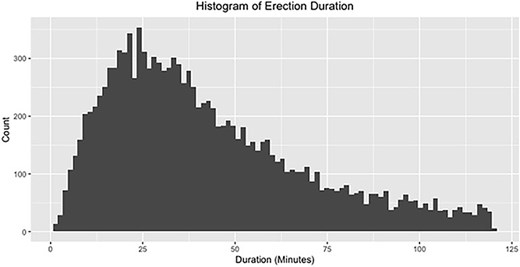-
PDF
- Split View
-
Views
-
Cite
Cite
G Saffati, D Orozco Rendon, R Daily, E Justin, M Khera, J Mulhall, ERECTION DURATION, FREQUENCY AND FIRMNESS: A DESCRIPTIVE ANALYSIS FROM A POPULATION-BASED STUDY USING A WEARABLE PENILE RING, The Journal of Sexual Medicine, Volume 22, Issue Supplement_2, May 2025, qdaf077.067, https://doi.org/10.1093/jsxmed/qdaf077.067
Close - Share Icon Share
Abstract
Erectile function is a crucial aspect of male sexual health and well-being, influenced by various physical and psychological factors. Traditional assessment methods have relied heavily on subjective self-reports and laboratory-based techniques, which often fail to capture the full scope of erections in real-world settings. The emergence of wearable penile ring devices marks a significant advancement, enabling continuous, objective monitoring of erections in naturalistic environments. This study aims to synthesize data collected from the FirmTech TechRing, a wearable penile ring device, and analyze the typical attributes of nocturnal erections.
The study employed a cross-sectional design, with data collected from July 2023 to June 2024. All patients who utilized the FirmTech TechRing for a minimum of four hours per night during this period were included. The device measures erection frequency, rigidity, and duration through embedded sensors. De-identified data were analyzed using descriptive and inferential statistical methods to assess typical attributes of nocturnal erections.
A total of 774 participants were included, encompassing a total of 4653 recorded observations. The median recording duration was 7.75 hours (IQR: 6.67, 8.82 hours). Analysis revealed a total of 12 581 erections, with a median duration of 36.2 minutes (IQR: 22.0-57.8 minutes), as summarized in Fig. 1. Participants experienced a median of 2.72 erections (IQR: 2.0-3.5) per recording, with a median firmness score of 4.69 on a scale of 1 to 10 (IQR: 3.28-7.02). These findings align closely with previously reported ranges, underscoring the validity of the data obtained from penile ring devices.
This study offers an unprecedented glimpse into the objective characteristics of male erections in naturalistic settings. By leveraging the capabilities of wearable technology and objective data collection, researchers and clinicians can continue to unravel the complexities of penile physiology and develop more effective strategies for the prevention, diagnosis, and management of erectile dysfunction and other sexual health concerns.
EJ and RD work for FirmTech. JM is an advisor to FirmTech.




